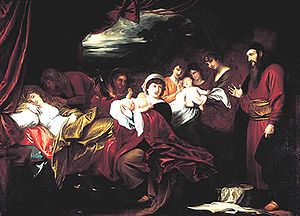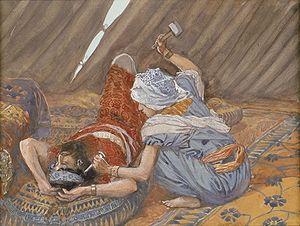by Kathy Brasby | Jul 19, 2013 | Hope
A literary technique that biblical authors use extensively is the motif. A motif is a recurring theme or distinctive feature woven through a literary text.
A common motif in the Bible is the barren women.

Esau and Jacob Presented to Isaac (painting circa 1779–1801 by Benjamin West) (Photo credit: Wikipedia)
We first encounter this motif in the story of Abraham and Sarah found in Genesis. In that story, Abraham is promised a son who will become the first of many descendants: a great nation.
The problem is that Abraham’s wife, Sarah, is too old to bear a child. She has never had a child. She is barren.
However, following the promises of God, Sarah becomes pregnant and delivers Isaac. Isaac in many ways has a significant role on the Old Testament story line. He is the father of Jacob who is the father of twelve sons who become the heads of the twelve tribes of Israel.
A significant man is born from a barren woman.
The motif continues in Isaac’s life, when his wife, Rebekah, is unable to conceive until he prayers for her. Then she delivers twins. The reader is ready to see if the barren woman motif is incorporated in this story – and it is. One of the twins is Jacob.
Jacob’s beloved wife, Rachel, also is unable to have children while Jacob’s other wife, Leah, is prolific. But eventually Rachel produces two sons. The oldest is Joseph, who ends of as second in command in Egypt.
From there, he provides protection for his family during a devastating famine. The family of Jacob moves to Egypt and, during their time there, grows from a family to a nation.
So we have three barren women – Sarah, Rebekah, Rachel – all delivering men significant to the history of Israel.
The motif continues with stories of Samson’s mother, Samuel’s mother, and Obed’s mother (Ruth, who had been married for 10 years without offspring). In each case, the son born to the formerly-barren woman had great significance.
Samson became a judge who helped the Israelites overcome Philistine oppressors. Samuel was the last of the judges and the man who anointed King David. Obed was the grandfather of David.
The motif continues into the New Testament. John the Baptist, the last prophet before Jesus, was born to Elizabeth, a barren woman. Each barren woman conceived through a miraculous touch of God.
Consider the birth of Jesus, born to a virgin who conceived through a miraculous touch of God.
In the Bible, the son born in a miraculous way will become a man of significance. Biblical texts use a motif – in this case, the barren woman – to highlight the theme.
Like this:
Like Loading...
by Kathy Brasby | Jul 16, 2013 | Hope
I have a friend who claims to love doing laundry. She’s still my friend, which, I hope, reveals a ton about my tolerance level.
Who loves doing laundry?
Not me.
My children were all instructed in the operation of our washing machine so that, by the time they could climb, they could do their own laundry. OK, maybe that’s a bit of a hyperbole but it still stands as a standard to attain.
I do admit that the result of requiring the kids to do their own laundry is that they now can use their bedroom dresser drawers for books and computer programs because those drawers never see clothes. They draw clean clothes from the laundry baskets.
At least that’s the theory. Sometimes clean and dirty co-mingle on the floor.
I did mention I’m tolerant, right?
I cannot blame my upbringing for this laundry tolerance. My mother was a Type-A laundrist. A laundrist is someone who takes the chore of laundry seriously. Even to the point of folding and stashing clothes on the same day they were washed.
I remember how Mom resisted changing from a wringer washing machine (see photo) because it cleaned fast and deep. But I’m happy to report that I was the reason she moved into the modern era of washing machines and dryers.
One day she was hanging up clothes in the back yard and I, being about 3 at the time, decided to explore without her supervision. What, I thought to myself, would happen if I stuck this knife blade in the electric socket?
I don’t remember what happened but I do know that Mom got a clothes dryer and that for years we had a butter knife in our flatware drawer with a blackened point.
One day my husband came home with a story about the wife of one of his customers who ironed all her husband’s underwear. I was so pleased I had the strength of character to resist such laundrist temptation. I know it wasn’t a hint. My husband has no illusions about my laundry abilities.
I mean, I don’t even fold my own underwear. Why would I iron his?
But recently our washing machine went belly up and my husband decided he wanted a front-loading set, those new energy-efficient machines that should save water and electricity.
So we have a new set with portholes facing into our laundry room. My husband is still bummed that the dryer doesn’t fold the clothes, too, but he’s adjusting. I’m bummed the clothes don’t come out on hangers. I’m adjusting, too.
But I do have one concern. Our grandson, at 18 months, now likes to stand at the glass windows and watch the clothes tumble.
I’m worried that this might be planting the seeds of a whole new generation of laundrists.
Like this:
Like Loading...
by Kathy Brasby | Jul 12, 2013 | Hope
Authors learn early to do their best not to repeat words. Repeating words is monotonous in our English literature. Rather than use stairs four times in the paragraph, for example, use stairs and steps and pronouns. If you have to, rewrite to avoid repeats.
A useful biblical technique is word repetition and, ironically, we often miss it because our English translations plug in synonyms for the repetitions.
But in doing so, we sometimes overlook the author’s point.
For example, there is a return motif in the Bible. The story of Jacob is about a man returning to his homeland after 20 years of exile. The grand story of the Old Testament is the return of a remnant of people to Palestine after the Babylonian exile.
But the story I want to examine briefly is the return story of Naomi in Ruth 1.
The Hebrew word for return in Ruth 1 is shub, meaning return. It carries deep meaning and rich connotations of the rhythm of life, of people returning to a previous condition, of people going out and coming in.
At times, shub is translated return and at other times synonyms are employed. Those are similar in meaning but we miss the repetition which underscores the theme of return. Here is where shub is used in Ruth 1:
- Ruth 1:6 “…then she started to return with her…”
- Ruth 1:8 “Go back each of you to your mother’s house…”
- Ruth 1:10 “No, we will return with you to your people…”
- Ruth 1:11 “Turn back, my daughters, why would you go with me?”
- Ruth 1:12 “Turn back,my daughters, go your way…”
- Ruth 1:15 “See, your sister-in-law has gone back to her people and to her gods…”
- Ruth 1:15 “Return after your sister-in-law…”
- Ruth 1:16 “Do not press me to leave you or to turn back from following you.”
- Ruth 1:21 “The Lord has brought me back empty…”
- Ruth 1:22 So Naomi returned together with Ruth.
- Ruth 1:22 …her daughter-in-law who came back with her.
That many uses of shub mean something. Although the translation obscures the repetition of shub, we still can uncover what the author intended. He wrote about Naomi’s return. His repetition clarifies his point.
Naomi was returning to her homeland and to God. She was returning to the fullness she thought God had torn away from her. She was returning to the kindness of God’s plan.
Word repetition set the stage for the author’s intended purpose in Ruth.
Like this:
Like Loading...
by Kathy Brasby | Jul 8, 2013 | Hope
The secretary and I were the only two women working in this shop. There’s something about rubbing elbows with a bunch of guys that can give you bad dreams.

(Photo credit: Wikipedia)
Let me explain.
The secretary was deathly afraid of mice. This was not a good thing to reveal to a bunch of guys but there it was.
I wasn’t overly fond of mice myself but determined not to admit to it. But the guys still tested me. I was in charge of checking in shipments – large and small – at our business and so one day found a small plastic bag on my desk. This wasn’t really unusual and I flipped the bag to check the shipping tag.
A dead mouse was stapled inside the bag.
I dropped the gift and looked up to see our service manager and parts manager peering around the corner watching. The service manager threw his hands in the air.
“It wasn’t my idea!”
And the parts manager put his hands up, too. “I didn’t put that bag on your desk.”
I decided to ignore Tweedledee and Tweedledum that day.
They didn’t harass me again – not enough hysteria to suit them, I’m sure – but one day our secretary came back from lunch to find a brown lunch bag on her desk. Stapled shut and wiggling.
She ran screaming to the break room, sure they had trapped a live mouse for her.
After shaking her hands and sobbing forever, she still refused to enter her office. So the service manager retrieved the bag from her office and brought it out, where he sliced off the top and set the trapped frog free.
Tweedledee and Tweedledum spent the afternoon freshening up the secretary’s desk before she’d return to work. Boss’s orders.
Something good did come out of it, though. Whenever the two guys got the idea to go in search of mice, they remembered four hours of scrubbing a desk and sat down until that idea passed.
Like this:
Like Loading...
by Kathy Brasby | Jun 28, 2013 | Hope
A woman killing a military hero makes for an unexpected story and Jael’s grisly slaying in the book of Judges contains an striking motif that uses vivid images to make the story spring to life.

English: Jael Smote Sisera, and Slew Him, circa 1896-1902, by James Jacques Joseph Tissot (French, 1836-1902) or follower, gouache on board, 5 7/16 x 7 3/8 in. (13.9 x 18.8 cm), at the Jewish Museum, New York (Photo credit: Wikipedia)
The account of Jael and Sisera takes place within the story of Deborah, a judge of Israel who led a great victory over the army of Jabin, king of Canaan, lead by Sisera.
Sisera’s army is routed in spite of its superiority and Sisera flees on foot, with Barak, the Israelite general, in pursuit. Sisera flees to the tent of Jael, assuming to find sanctuary because of the peace between Jabin and Jael’s husband, Heber.
A nurturing, maternal motif forms in the story. Jael is first seen in her tent and comes out to invite Sisera in. Twice she calls him to “turn aside” and tells him to have no fear. The tent, as the woman’s domain, can be seen as a womb. In inviting Sisera to enter, there is a sense of protection as a baby in a womb.
That imagery continues as she covers Sisera with a rug as a mother might cover a baby. He asks her for a drink of water like a child might ask its mother. Jael, however, gives Sisera milk – more than he asked for and more comforting – and then covers him again, evoking further images of a mother and baby.
Sisera asks Jael to stand guard at the door of the tent and tell any men, “There is no man within.” From Sisera’s point of view, he has commanded her to protect him by lying, confident in his military authority. But Sisera has figuratively regressed from manhood to childhood in blindly trusting Jael; there really is no man within the tent.
Sisera sleeps like a baby, for although he has the leader of the opposition chasing him, he is able to trust Jael enough to sleep.
She takes up the hammer and tent peg – tools of a woman in that culture because they were the ones who moved the tents– and goes quietly to him like a mother tiptoeing to her child’s bedside to check his breathing while he sleeps.
However, the story violently twists and Jael drives the peg into Sisera’s head, killing him.
Jael is a hero to her people and yet the imagery makes us squeamish. We grapple with the motif twisted. How could a mother betray her baby? Why did Sisera relinquish his trust and his life to this woman?
Striking use of imagery makes Jael’s story a powerful one with many questions to be explored.
Like this:
Like Loading...
by Kathy Brasby | Jun 24, 2013 | Hope
This puppet show was not supposed to happen.

(Photo credit: Wikipedia)
After traveling over 1200 miles to work for a small church in Mexico, including preparing a 30-minute puppet performance for their children, I was bedridden with the flu and a 102-degree temperature all week.
Fortunately I was part of a team that worked without me but I was in charge of the puppet show.
By Sunday morning, when the performance was planned, I felt well enough to help prepare the props and set up our stage.
And then two of our teenage puppeteers approached us, faces like a birthday child with no gifts. “We just found out that Mary bought drug paraphernalia this week and tried to hide it in Teresa’s suit case.”
What do you say to that?
Mary had joined our team at the last minute and no one knew her very well. We just hadn’t realized how un-well we knew her. I envisioned a church team getting busted at the border for paraphernalia possession – and sweet Teresa getting the blame.
Nothing like a little distraction when you’re trying to put a performance together.
We drew in a team breath – no easy task when half the team was still hyperventilating over Mary’s deception – and continued on. The props were ready, puppets laid about, puppeteers ready – and the electricity went out. We needed electricity for our music.
Power outages, we learned, were not uncommon in this neighborhood. Why hadn’t we packed batteries for the CD player? For the same reason we had let Mary join the team. Not thinking well.
We dispatched someone to buy batteries. He returned with four D batteries purchased for $20, which was highway robbery, and we punched them into our player. We then found out what highway robbery really is: buying batteries that were dead for $20.
So my innovative husband threw himself into building an adapter that would run the CD player off a car battery. Visualize that. The car battery was bigger than the CD player.
He stripped wires and taped ends together. Five minutes before the performance time, he gave me a thumbs up.
And then the electricity came on.
We completed the show and then the lights went out again.
But the audience applauded our show and several came forward with questions and commitments for the pastor.
In spite of the flu, Mary the paraphernalia smuggler, and power issues, the puppet show that couldn’t happen did happen. And with a resounding “yes!”
Perseverance matters.
Like this:
Like Loading...





